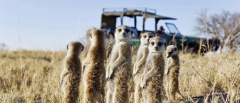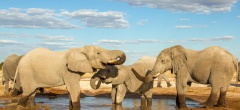The Makgadikgadi Salt Pans
One of the oldest inhabited areas on the planet
The Nxai, Sua and Ntwetwe salt pans, collectively known as the Kalahari Desert’s Great Salt Pans are the remnants of a prehistoric time when the highland rivers of Angola used to flow all the way to what was one of Africa’s largest lakes, Lake Makgadikgadi. Today, these caustic white dust bowls do still, seasonally, play host to some of Botswana’s largest grazing herds in the form of the zebra and wildebeest migrations along with some or Africa’s hardier and more resilient species such as the oryx.
The Makgadikgadi Pans Game Reserve
Arguably the most famous region in the great pans, the Mkgadikgadi Game Reserve is certainly the most accessible area within the pans region with properties such as Meno a Kwena and the excellent Jack’s and San Camps located on the western and eastern edges of the park itself. In reality, however, the game reserve is really a ‘park’ in the loosest sense of the word as this is an area of the Kalahari that is pretty inhabitable by normal standards and, as such, there is no huge need to protect a specific area as such.
Activities in the salt pans
A visit to the Makgadikgadi is all about visiting what is one of the true cradles of mankind with human inhabitation in the region for the longest period in history. A visit to the San bushmen offers a glimpse into the nomadic and subsistence lifestyles that punctuated early human existence. Today the ceremonies and knowledge that were once a staple to the tribe’s existence are preserved more for tourism than as a means of living but learning about their culture is still one of the most rewarding cultural experiences to be had in Africa and visiting ‘Kubu Island’ you will be one of a very privileged few to see one of the 5 oldest rock formations on the planet and a highly revered cultural site for the San.
From a bio-diversity perspective the area has the widest species range of any desert in the world and has more species in this one area than the entire species range of Australia! The region is fed by Boteti River which runs out from the southern most point of the Okavango Delta and the area is a classic example of a ‘boom or bust’ eco-system where the rainy months, between December and April, offer mineral rich grasses and the dry months from May to November virtually nothing.
Best time to visit the Makgadikgadi
The dry season runs from May to November and offers better access to the pans, desert dwelling animals, quad bike safaris, flamingo breeding ground access and visiting Kubu Island.
The wet season runs from December through until April and is when the grasses arrive and the pans fill with water. This is the period when the famous zebra migration are in the pans with their young offspring. Birding is also very good around this time but access can be much harder.


